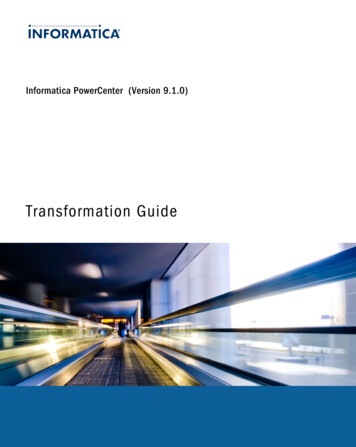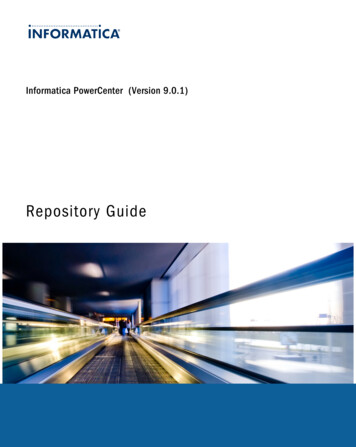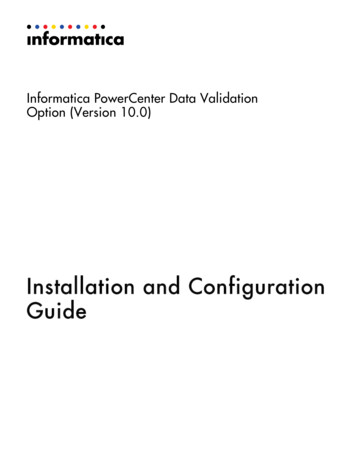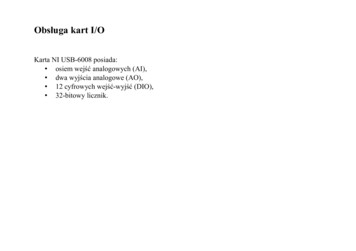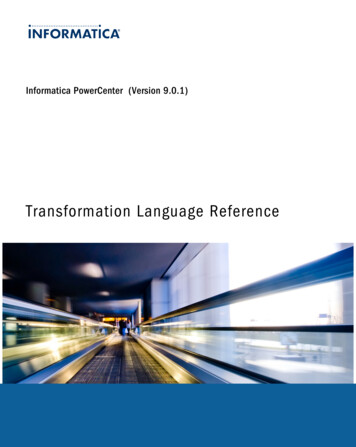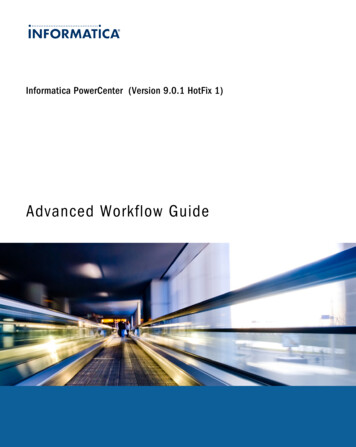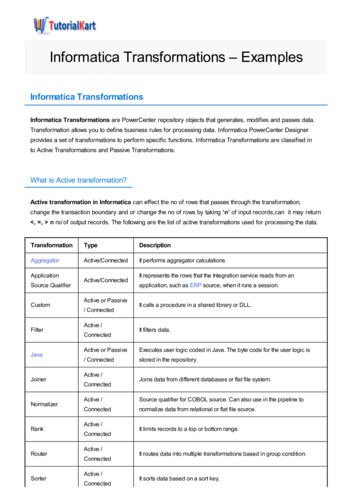
Transcription
Informatica Transformations – ExamplesInformatica TransformationsInformatica Transformations are PowerCenter repository objects that generates, modifies and passes data.Transformation allows you to define business rules for processing data. Informatica PowerCenter Designerprovides a set of transformations to perform specific functions. Informatica Transformations are classified into Active Transformations and Passive Transformations.What is Active transformation?Active transformation in Informatica can effect the no of rows that passes through the transformation,change the transaction boundary and or change the no of rows by taking ‘n’ of input records,can it may return , , n no’of output records. The following are the list of active transformations used for processing the /ConnectedIt performs aggregator calculationsApplicationSource QualifierActive/ConnectedIt represents the rows that the Integration service reads from anapplication, such as ERP source, when it runs a session.CustomActive or Passive/ ConnectedIt calls a procedure in a shared library or DLL.FilterActive /ConnectedIt filters data.JavaActive or Passive/ ConnectedExecutes user logic coded in Java. The byte code for the user logic isstored in the repository.JoinerActive /ConnectedJoins data from different databases or flat file system.NormalizerActive /ConnectedSource qualifier for COBOL source. Can also use in the pipeline tonormalize data from relational or flat file source.RankActive /ConnectedIt limits records to a top or bottom range.RouterActive /ConnectedIt routes data into multiple transformations based in group condition.SorterActive /ConnectedIt sorts data based on a sort key.
Source QualifierActive /It represents the rows that the Integration service reads from a relational orConnectedflat file source when it runs a session.TransformationActive /ControlConnectedUnionActive /ConnectedUnstructuredActive or PassiveData/ ConnectedUpdate StrategyActive /ConnectedIt defines commit and rollback transactions.It merges data from different database or flat file system.Transforms data in unstructured and semi-structured formats.It determines whether to insert, delete, update or reject rows.XML generatorActive /ConnectedReads data from one or more input ports and outputs XML through asingle output port.XML ParserActive /ConnectedReads XML from one or more input ports and Outputs data to one ormore output ports.XML SourceQualifierActive /ConnectedRepresents the rows that the Integration service reads from an XMLsource when it runs a sessionWhat is passive Transformation?Passive Transformation in Informatica that does not affect the number of rows that passes through thetransformation, maintains the transaction boundary and it does not change the number of rows by taking ‘n’no’of input records and returns the same no of output records. Following are the list of passive Transformationsused for processing the e / ConnectedIt calculates a value.HTTPPassive / ConnectedIt connects to an HTTP server to read or update data.InputPassive / ConnectedIt defines mapplet input rows and available in the Mappletdesigner.LookupPassive / Connected orUnconnectedLooks up values.OutputPassive / ConnectedIt defines mapplet output rows and available in Mappletdesigner.Passive / ConnectedIt generated primary keys.Passive / ConnectedIt calls a stored procedure.SequencegeneratorStoredprocedure
Unconnected TransformationInformatica Transformation can be connected to the data flow, or they can be unconnected. An unconnectedtransformation is no t connected to other transformation in the mapping and called within anothertransformation, and returns a value to that transformation.How to create an Informatica Transformation.Informatica transformation can be created using Designer tools such as Mapping Designer, Transformationdeveloper and Mapplet Designer, then configure the transformation by adding ports, properties, groups,expressions and son on and finally link the transformation to other transformation and target definitionsby drag and drop method in the mapping or mapplet.Mapping Designer: Mapping Designer in Informatica creates transformations that connects Source to Target.Transformation Developer: Transformation developer crates individual transformations called reusabletransformations that can be used in other mappings.Mapplet Designer: Mapplet designer creates and configures transformations called as Mapplets, thesetransformations can be used in multiple mappings.ConclusionI hope this Informatica Transformations tutorial was helpful to understand the basics of InformaticaTransformations and in our upcoming Informatica Transformations tutorial, we will learn about eachtransformation in detail with example.Informatica Introduction
Informatica Tutorial - Home What is Informatica? Informatica - Architecture. Informatica - PowerCenter Repository Service Informatica - What is PowerCenter Integration Service? What is PowerCenter Repository Manager What is informatica PowerCenter Designer? Informatica - Data Transformation Manager (DTM) Informatica - DTM Threads Informatica - Load Balancing Different ETL tools in Informatica What is Mapping architect for Visio? Informatica - PowerCenter 10.0.1 Installation Step by Step Informatica - Creating Integration Service Creating Informatica Repository Service Configuring Client Domain in Informatica Learn how to create ODBC connections in Informatica Creating Source Analyzer in Informatica Creating Target designer in Informatica Create Users and Folders in Informatica Setting up Target Database in Informatica Learn and Create Workflows in Informatica Learn and Create Mapping in Informatica Learn and Create a session in Informatica Informatica PowerCenter Repository Backup / Restore stepsInformatica Transformations Introduction to Informatica transformations Aggregator Transformation Filter Transformation Lookup Transformation Rank Transformation Router Transformation
Update Strategy Transformation Joiner Transformation Expression Transformation Source Qualifier Transformation Sorter Transformation Union Transformation Normalizer Transformation SQL Transformation Sequence Transformation Stored Transformation Transaction Control Transformation XML Generator Transformation XML Parser Transformation
Informatica Transformations are PowerCenter repository objects that generates, modifies and passes data. Transformation allows you to define business rules for processing data. Informatica PowerCenter Designer provides a set of transformations to perform specific functions. Informatica Transformations are classified in to Active Transformations and .
